China
In ancient China, musical instruments were divided into “eight sounds” (bayin) based on the materials used in their construction: metal (jin), stone (shi), silk (si), bamboo (zhu), gourd (pao), leather (ge), wood (mu) and clay (tao). Today, imperial court and ritual musical instruments associated with this early classification system are reconstructed for use in ensembles that perform in museums and historical buildings. In this display of porcelain instruments from China, we refer to them by their modern day classifications. Included are aerophones (wind instruments) and chordophones (stringed instruments), originally called “sizhu “ – silk and bamboo.
In China, porcelain is defined as pottery that is resonant when struck. In the West, it is defined as a material that is translucent when held to the light, however this is only partially correct as there are always exception. Porcelain (pottery) was first made in China in a primitive form during the Tang dynasty (618–907). The porcelain form best known in the West was made during the Yuan dynasty (1279–1368) and is represented in these musical instruments.
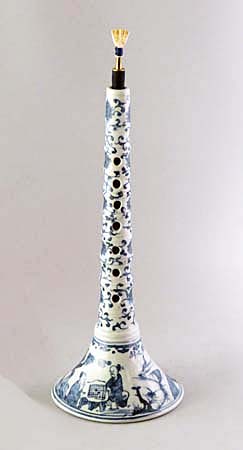
Suona – Double Reed Horn
China
Porcelain
1800s
Usually made of wood with a metal bell, the suona was first introduced in the 1500s to China from Persia. It has a distinctively loud sound and is used in Chinese traditional musical bands/ensembles.
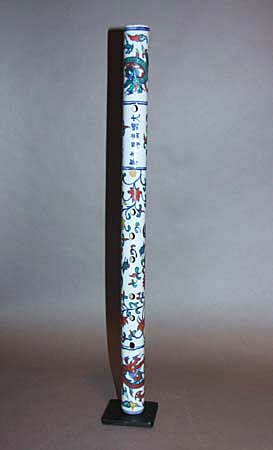
Dizi – Transverse Flute (signed)
China
Multi-color Porcelain
Mid 1900s
A vibrant ‘Wani’ (five color ware) style doucai glazed porcelain ‘dizi’ (flute) with dragons, phoenix birds, concentric circles. This signed and inscribed porcelain flute specifically shows the mythological Chinese Phoenix bird Fenghuang. The Fenghuang is a bird that has the head of a peacock, body of a swan, and wings of a golden cockerel. In Chinese mythology. Phoenixes are messengers of happiness.
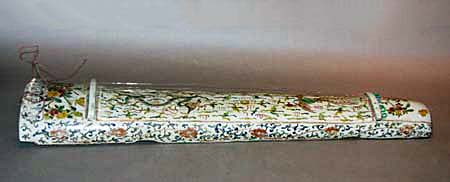
Guqin – Ancient seven-string zither (signed)
China
Porcelain
1600s
This guqin (pronounced guchin) was made during the Kangxi Period of the Qing dynasty (1661-1722 C.E.). In Chinese, “gu” means old and “qin” means “musical instrument.” It is China’s oldest stringed instrument, with a history of some 3,000 years.
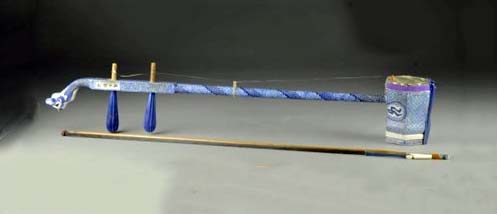
Erxian – Two-string Bowed Lute of the “Huqin” Family
China
Porcelain, string, hide
1800s
The erxian is used primarily in Cantonese opera and originated in southern China’s Guangdong Province. It is a relative to the erhu. The difference is that the back of the sound chamber of the erxian is not covered with lattice work, like those of the erhu or gaohu, and the erxian usually has a very ornate dragon head.
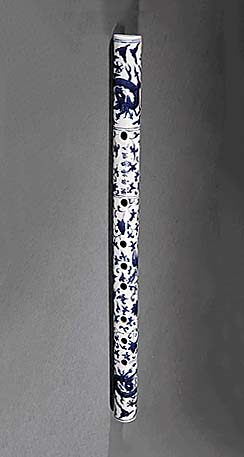
Dizi – Transverse Flute (signed)
China
Blue & White Porcelain
1800s.
A Chinese blue and white porcelain inscribed transverse flute – ‘dizi’. The cylindrical body is decorated at each end with symbolic dragons. The dragon symbolizes courage, stability, and superiority. Bamboo is the typical material for these flutes.

Xun – Ten-hole Globular Flute
China
Porcelain
1900s
The xun is a globular, vessel flute recognized as one of the oldest musical instruments in China. Archaeologists believe that during ancient times people would drill holes in a mud ball and tie it to a rope to use for hunting wild animals. The sounds from the ball, with holes whirling through the air, made varied sounds. Eventually, people began blowing air into the ball where the holes were made, and it became a musical instrument known as the xun (ocarina). By the Zhou dynasty (1046-256 B.C.E.), it was a common musical instrument played in the Imperial Courts. The design of the xun varied according to whether it was played for enjoyment or for celebrations.
